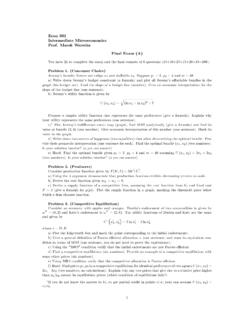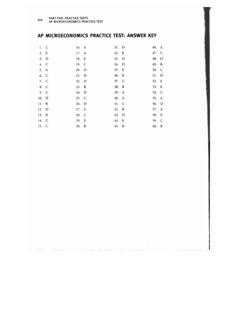Transcription of Section 1 Microeconomics: Answers to Test your ...
1 Cambridge Resources for the IB Diploma Copyright Cambridge University Press 2012. All rights reserved. Page 1 of 28 Section 1 microeconomics : Answers to Test your understanding quantitative questions (Chapters 2 7) Answers have been provided for all quantitative Test your understanding questions throughout the textbook. Chapter 2 Competitive markets: demand and supply Test your understanding (page 35) 2 (a) Find at least 2 points on the curve and plot. For example: if P = 2, Qd = 70 7(2) = 70 14 Qd = 56; this gives the point (56,2) if P = 3, Qd = 70 7(3) = 70 21 Qd = 49; this gives the point (49,3) if P = 4, Qd = 70 7(4) = 70 28 Qd = 42; this gives the point (42,4) The third point is to check that you are getting a straight line.
2 (Recall that any point on a graph can be represented by (h,v), where h is the value of the variable on the horizontal axis and v is the value of the variable on the vertical axis; see Quantitative techniques chapter on the CD-ROM, page 8.) However, the easiest way to plot a demand curve is to find the horizontal (Q) and vertical (P) intercepts, as these are the end-points of the demand curve: Horizontal (Q) intercept: set P = 0 Q = 70 7(0) Q = 70 (this is simply the value of the parameter a in the function Qd = a bP) Vertical (P) intercept: set Qd = 0 0 = 70 7P 7P = 70 P = 10 The line joining the two intercepts is the D curve.
3 (b) When P = 2, Qd = 70 7(2) = 70 14 Qd = 56. Using the same method, you find that when P = 5, Qd = 35 when P = 8, Qd = 14 (c) This was done in part (a) above. (d) The graph of the D curve should cut the horizontal (Q) axis at Q = 70, and the vertical (P) axis at P = 10 3 (a) The new D curve will shift to the right by 15 units measured along the horizontal (Q) axis and will be parallel to the initial D curve. (b) Qd = 85 7P (c) Vertical (P) intercept: set Qd = 0 0 = 85 7P 7P = 85 P = Horizontal (Q) intercept: set P = 0: Q = 85 (this is the new value of the parameter a)Cambridge Resources for the IB Diploma Copyright Cambridge University Press 2012.
4 All rights reserved. Page 2 of 28 4 (a) The new D curve will shift to the left by 20 units measured along the horizontal (Q) axis and will be parallel to the initial D curve. (b) Qd = 50 7P (c) Vertical (P) intercept: set Qd = 0 0 = 50 7P 7P = 50 P = Horizontal (Q) intercept: Q = 50 (this is the new value of the parameter a). 5 (a) 7 (b) You can easily graph the new D curve after answering (c) and (d) below. Knowing the vertical (P) intercept and the horizontal (Q) intercept, you can draw a line from P = 14 (where Q = 0) to Q = 70 (where P = 0).
5 (c) Qd = 70 5P (d) Vertical (P) intercept: set Qd = 0 0 = 70 5P 5P = 70 P = 14 Horizontal (Q) intercept: set P = 0 Q = 70 Note that when the slope changes, the horizontal (Q) intercept (or the value of the parameter a) does not change; you can also see this in your graph. (e) The absolute value of the slope decreases; therefore the D curve becomes steeper. This should be clear in your graph. Test your understanding (pages 37 8) 2 (a) You can find at least two points on the S curve and plot (as shown in Test your understanding , question 2(a) above, for the D curve).
6 However, the easiest way to plot an S curve is by first seeing if the Q-intercept, or the value of c in the supply function Qs = c + dP, has a positive or negative value. If c > 0, this means that the S curve begins from the horizontal (Q) axis; you should therefore find the horizontal intercept plus at least one more point, which will give you the S curve. If c < 0, this means that the S curve begins from the vertical (P) axis; you should therefore find the vertical intercept plus at least one more point, which will give you the S curve.
7 (For an explanation of these points, see Quantitative techniques chapter on the CD-ROM, page 22.) In the question here, the horizontal intercept, or the value of c is negative (c = 20); therefore you should begin by finding the P-intercept: Set Qs = 0 0 = 20 + 10P 10P = 20 P = 2 To find a second point, you should use a value of P > 2 to solve for Qs (since any P < 2 gives a negative value for Qs, which is not of interest): If P = 3, Qs = 20 + 10(3) = 20 + 30 Qs = 10; this is point (10,3) If P = 4, Qs = 20 + 10(4) = 20 + 40 Qs = 20.
8 This is point (20,4) (The third point is to check that you are getting a straight line.) Cambridge Resources for the IB Diploma Copyright Cambridge University Press 2012. All rights reserved. Page 3 of 28 (b) When P = 3, Qs = 10 When P = 4, Qs = 20 When P = 6, Qs = 40 (c) Vertical (P) intercept: set Qs = 0 P = 2 (this was found above) Horizontal (Q) intercept: set P = 0 Q = 20 (this is simply the value of the parameter c) The horizontal intercept of Q = 20 does not appear in the graph. (d) The non-negative intercept is the vertical (P) intercept, which is P = 2 (this is what your graph should show).
9 3 (a) The new S curve will shift to the right by 15 units measured along the horizontal (Q) axis, and will be parallel to the initial S curve. (b) Qs = 5 + 10 P (c) Vertical (P) intercept: set Qs = 0 0 = 5 + 10P 10P = 5 P = Horizontal intercept: set P = 0 Qs = 5 (this is the new value of the parameter c) The horizontal (Q) intercept of Q = 5 does not appear in the graph. 4 (a) The new S curve will shift to the left by 15 units measured along the horizontal axis, and will be parallel to the initial S curve.
10 (b) Qs = 35 + 10P (c) Vertical (P) intercept: set Qs = 0 0 = 35 + 10P 10P = 35 P = Horizontal (Q) intercept: set P = 0 Qs = 35 (this is the new value of the parameter c) The horizontal (Q) intercept of Q = 35 does not appear in the graph. 5 (a) +10 (b) To graph the new function, you need to first find the new S function (also asked for in part (c) below). This is Qs = 20 + 15P Find the vertical (P) intercept by setting Qs = 0 0 = 20 + 15P 15P = 20 P = To find a second point on the new S curve, find a Q for any value of P > (since if P < a negative Q results).










